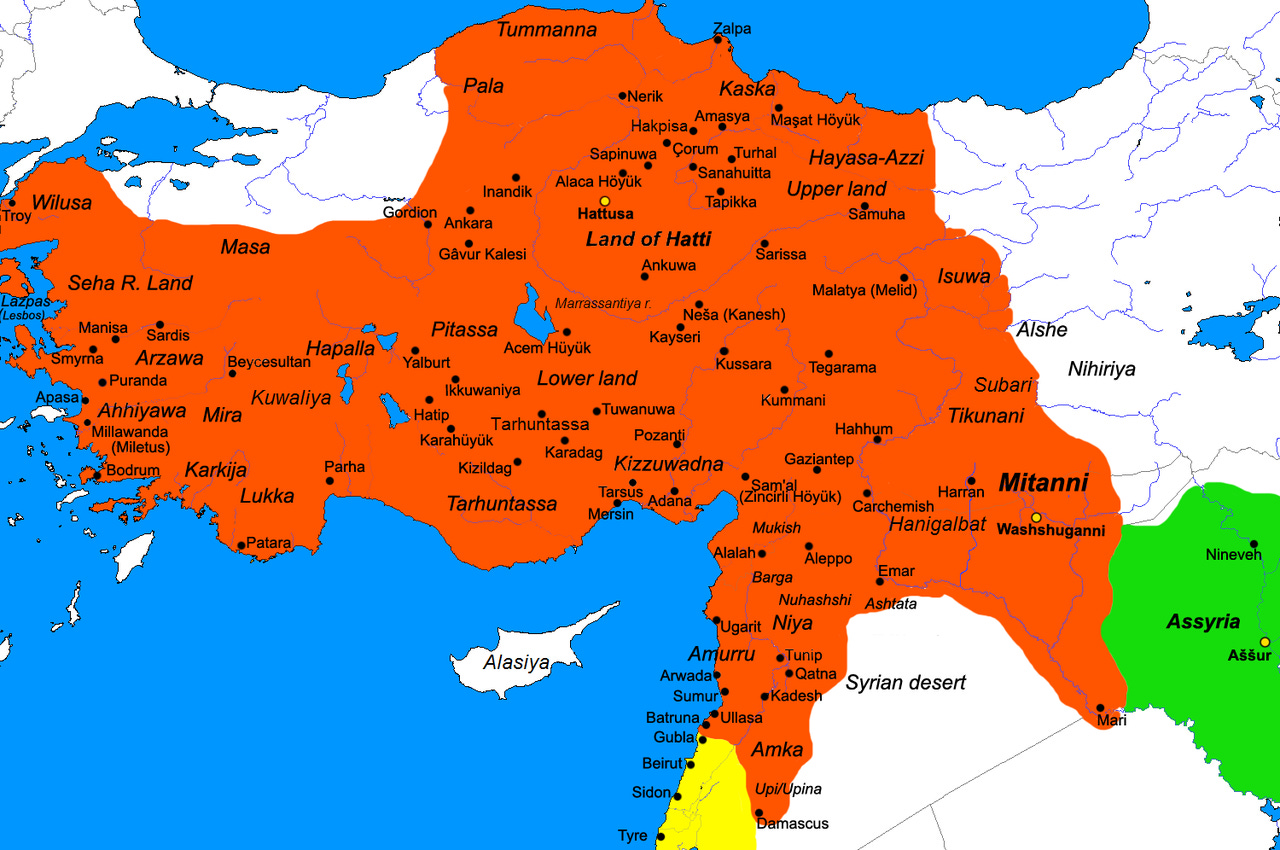As previously discussed in our Book on Japheth, the Anatolian “Hittites” were not the original inhabitants of their land. They were a noble class that took over the “Land of Hatti”, with the Hattian people having completely separate ethnic designations, and a different language. Unlike the Hittites, who spoke an Indo-European language closely related to their brethren the Luwians, the Hattians spoke neither Indo-European (Japhethite), or Semitic thus putting them somewhat closer to Hamitic speakers. While we are uncertain of the Hattic language and ethnic designations, they eventually assimilated into the “Hittites” as well as their neighbor groups like the Luwians, and Palaics.
Quoting the section on Togarmah, under Japheth: “Even the Torah failed to differentiate between Hittites and Hatti, using “Heth” interchangeably for both people with the clear lack of an ancient demarcation line between what was an obvious well known world super power. The Torah calling all “Hittites” as “Heth” or “Children of Heth” would be comparable to referring to “Native Americans” and “Americans” all with a singular term “American” despite one group's political existence before the other.....There was a “Hittite son of Japheth, the Indo-European”, but also a separate Hatti people. Indeed, Heth is likely a candidate for the Hatti, who were, like most of the Mizraim, more ancient than the people that supplant them from Japheth and Shem.”
A tenuous differentiation point for the Hatti and Hittites could be the use of the term “Hatti” vs “Bnei Heth”, in Hebrew “חתי” vs “בני-חת” modified with the word ‘children’. The most notable difference in these terms is the “Yud” at the end of “Hatti” which might signify the Hittites under their newly acquired name “Hatti”. The ‘children of Heth’ would therefore be the actual sons of Heth, son of Canaan, in other words the native Hatti Anatolians who eventually move north into the Syro-Hittite states neighboring the Amorites.
The only usage of the term “Bnei Heth” is in Genesis, frequently employed around the activity of Avraham in Canaan. The most helpful of these references comes in Genesis 23:7 during Avraham’s journey to purchase a burial site, known as the Cave of Machpelah, where we get the line “And Avraham arose and prostrated himself to the people of the land, to the sons of Heth.” The term here are “sons of Heth”, or Bnei Heth, with the explicit implication these people dwell in the land of Canaan and not Anatolia further north. This cave is definitively in Israel, and one of the earliest “land deeds” given Avrahams claim over the region. While often overlooked, the first sign of a Jewish community is not a synagogue, but rather the existence of burial sites, helping affirm the earliest settlement of Canaan by Avraham.
Interestingly, other than the purchase of the Cave of Machpelah the only other event in reference to the “Bnei Heth” is Esau’s two wives, both “Hittites”, rather Bnei Heth. While there may have been children of Heth in Canaan during the time of the patriarchs, by the return of the Israelites following the Exodus it is clear there is a quintessential difference in who these people are as their identity shifts from a “Canaanite Heth” to a “Indo-European Heth”. This period likewise corresponds to the expansion of the Hittite Empire and interaction between them and the Ramessid Egyptians from the time of the Exodus and beyond when the Hittites would have assimilated the label “Hatti”. A quick aside, but Heth means Terror in Hebrew, potentially in reference to these peoples upheaval of the geopolitical world order under the Hittite Empire.
While the Syro-Hittites date to well after the time of Abraham during the Judges period and may represent the peoples interacting with the Israelites in that period, the people mentioned as Heth earlier before the arrival of the Hittite Empire in the 1600s BCE would have been the Hatti descendants of Canaan. These are the people whom Avraham bought his cave from, and their lack of a defined Kingdom, or Empire, explains why the interactions are so infrequent compared to the later Hittites.
Helpful in identification of these people is actually the price of the cave paid by Avraham. Famously Ephron the ‘Hittite’ (who in this case should be read as Ephron the Hattian) offers Avraham the cave for a price of 400 shekels of silver upon which Abraham accepts immediately. While at first glance unimportant, the actual price of the land being 400 shekels squares away with real estate contracts found in Ugaritic texts. Ugarit was another major city, nearly the center of the Canaanite world on the northern coast, and three out of six contracts found were purchased for a sum of 400 silver shekels, with the actual terms of the deal paralleling the Torah’s description of Machpelah.1 400 shekels was a common price for real estate in this period, attesting to the bibles accurate account of ancient monetary price scales.
Thus the correct nation slotting into the “Children of Heth” would be the Hatti, rather than the Hittites. In the period of Judges, meaning after 1100 BCE, the arrival of the Sea Peoples, and the collapse of the Hittite Empire, the references to Hatti, or Hittites, are neither the Hatti or the Hittite Empire, but rather the remnant Syro-Hittite Luwian speakers directly north of Canaan.
Stieglitz, Robert R. “Commodity Prices at Ugarit.” Journal of the American Oriental Society, vol. 99, no. 1, 1979, pp. 15–23.








